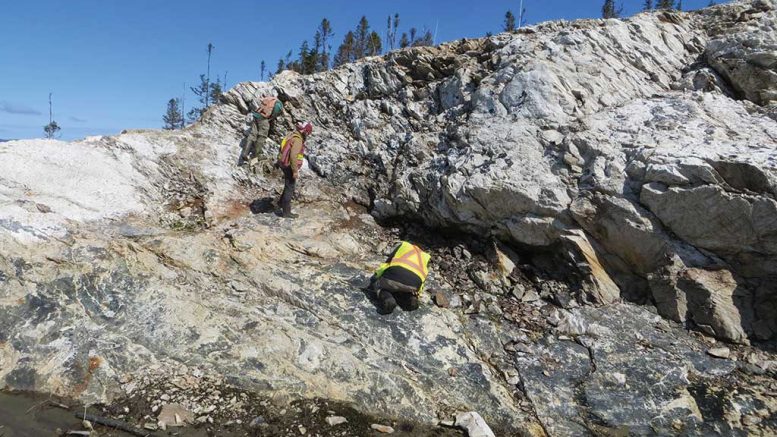Prospecting and trenching southwest of Marathon Gold’s (TSX: MOZ) Victory deposit in central Newfoundland have uncovered a 1,500-metre-long gold trend.
A channel sample returned 2.71 grams gold per tonne over 9 metres, while grab samples from newly exposed outcrop and trenches returned values up to 53.2 grams gold per tonne.
The company says trenching over the 1,500-metre strike length — close to the Valentine Lake Thrust Fault — exposed multiple zones of en-echelon stacked, southwest-dipping, quartz-tourmaline-pyrite gold veining that is “identical” to the mineralizing system found elsewhere throughout Marathon’s Valentine Lake gold camp, including its Marathon, Leprechaun, Victory and Sprite deposits.
“The new extension of gold showings in trenches is very encouraging in providing an opportunity to further increase the open-pit resources in the Victory area,” Phillip Walford, Marathon’s president and CEO, told The Northern Miner.
A drill rig has been mobilized to explore the gold zone, and prospecting and trenching are continuing in the southwest Victory gold trend area.
The Victory deposit hosts 952,000 measure and indicated tonnes grading 1.55 grams gold for 47,500 oz. gold, plus 1.7 million inferred tonnes at 1.456 grams gold for 78,400 oz. gold.

Marathon Gold’s Valentine Lake gold project in Newfoundland. Credit: Marathon Gold.
It is 6 km northeast of the company’s Marathon deposit, which contains 23.7 million measured and indicated tonnes at 1.87 grams gold.
Marathon’s 240 sq. km Valentine Lake Gold camp hosts four near-surface deposits with measured and indicated resources totalling 2.14 million oz. gold at 1.99 grams gold, and inferred resources totalling 1.11 million oz. gold at the same grade. All of the deposits are open to expansion.
Most of the defined gold resource is at the Marathon and Leprechaun deposits. The Marathon deposit was discovered five years ago and the Leprechaun deposit in the late 1990s.
A recent preliminary economic assessment (PEA) envisions producing 188,500 oz. gold a year over the first decade, with a payback of just under three years. The study estimated a US$367-million, post-tax net present value and 25.3% internal rate of return.
“Given the recent uncovering of each deposit [Marathon and Leprechaun], combined with the lack of significant exploration in the area prior to Marathon’s involvement, we see significant expansion potential beyond the 3.2 million oz. currently defined in the last resource estimate, with more than 18 km of strike length still to be explored,” Mick Carew of Haywood Securities writes.
“The recent results [of prospecting and trenching near the Victory deposit] demonstrate the expansion potential of the Valentine Lake project area, with a large proportion of the northeast- to southwest-striking structure associated with gold mineralization at Valentine Lake still untested … these results suggest the Victory resource could expand both in terms of grade and total ounces.”
The company will keep drilling Marathon’s deposit extensions, “but new areas for open-pit resources could help us to reach our goal faster,” Walford says via email.
“We want to see our current average production rate from the recent PEA move from 189,000 oz. gold on average over 10 years to 200,000 plus oz. over 10 years, just on open-pit material.”


Be the first to comment on "Marathon discovers gold trend"